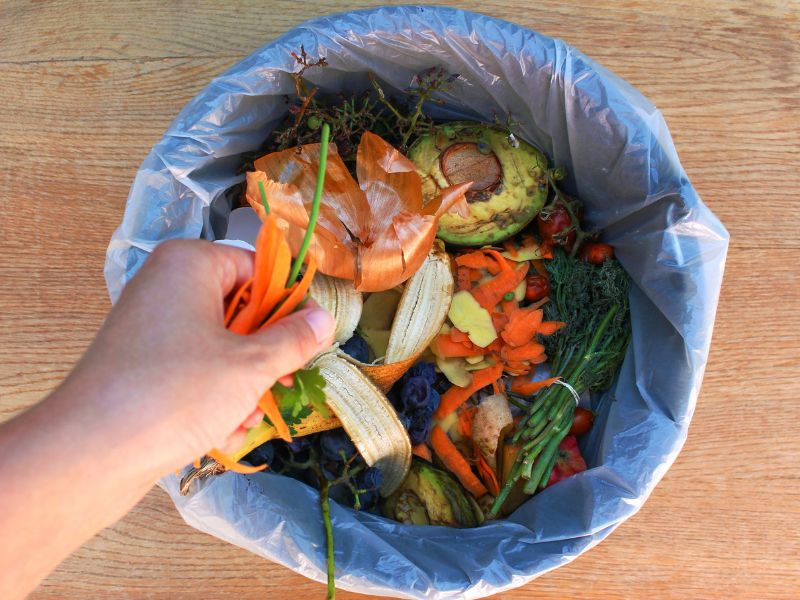How Can Cutting Your Food Waste Help the Climate?

Food waste is a common problem many households and food establishments are faced with. Throwing away food scraps and leftovers that could have been eaten seems like an easy solution but in reality has devastating outcomes. When food waste enters a landfill, it begins contributing to greenhouse gas emissions due to the anaerobic environment. When food scraps go into landfills and rot, they produce methane, a more potent greenhouse gas than carbon dioxide. Greenhouse gases are gasses that trap heat in the atmosphere, causing global warming and drastic weather changes.
The United States Department of Agriculture (USDA) reports that 30-40% of the food produced in the U.S. is wasted, and the Environmental Protection (EPA) states that 24% of global greenhouse emissions come from agriculture, forestry, and other land use.
Based on the special report of the Intergovernmental Panel on Climate Change (IPCC), the loss and waste of food caused 8% to 10% of gases emissions responsible for global warming from 2010 to 2016. This article will explore the connections between food waste and climate change.
How Consumers Can Play a Major Role in Addressing Food Waste
A 2021 survey published in the Frontiers in Sustainable Food Systems showed that 58% of participants said they waste 10% or less of procured food. When asked if they were willing to take additional action to reduce food waste, about 48% of the respondents showed eagerness in doing so.
The survey conducted at the household level in Montana in the United States is just a tiny portion of the whole population in the world. Unfortunately, for some people, wasting food has become a way of life.
One reason that much of the food brought by households is discarded could be improper storage of food items. There could also be a misunderstanding of expiration date markings.
Still, everyone can do their part to save food from going to waste. The FAO has given 15 tips to help individuals minimize food waste. Here are some of the agency’s recommendations.
Adopt a Healthier, More Sustainable Diet
When you’re pressed for time, it can be challenging to prepare a healthy and delicious meal. No wonder many people prefer to order fast food instead.
The work-from-home setup that became the norm during the pandemic may present an opportunity for some to prepare healthy meals for themselves instead of opting for takeout or delivery as often.
One way to reduce the total emissions is by going on a low-carbon diet, cutting down on meat and dairy and eating locally-grown produce.
Only Purchase What You Need
Planning your meals will help prevent overbuying. Each time you go to the groceries or order online, make sure to prepare a shopping list so you’ll have an idea of what to buy.
If you order cooked food and have it delivered, make sure that you don’t order too much, or have plans to use your leftovers. Pay attention to the amount of food that you and your family consume every day to order properly. Correct portioning helps you manage your budget wisely and avoid food waste.
Don’t Be Afraid of Oddly-Shaped or Bruised Vegetables and Fruits
Ugly fruits and vegetables are thrown away because they don’t pass aesthetic standards. “Imperfect” fruits and vegetables may not be Instagram material, but they have the same great taste and nutrition!
Store Food Wisely
The key here is organization. When putting items in your fridge, use labels if they are not in their original containers. Remember to place older food items (the first ones to expire) at the front and the new ones at the back.
Airtight containers help keep food fresh. Just make sure you close containers properly.
Understand Food Labeling
Do not confuse “use-by” with “best before” dates. Sometimes, it’s still safe to eat food items even after the “best before date.” If you’re concerned about safety, smell the food. If it smells bad, you’ll know it’s unhealthy to consume right away. For example, fresh milk may still be good for several days after the “best before date.” Tuning into your senses will quickly help you determine if it is past its prime.
Reuse Leftovers
Keeping chopped vegetables is easy and a great way to meal-prep. Put them in an airtight container to keep them fresh. You can also use leftover proteins (like a piece of pork chop or chicken) to flavor vegetable dishes or make soup.
Start Composting
The EPA reported that yard waste and food scraps make up more than 30% of what people throw away. Instead of throwing away your food scraps, composting them returns this organic material to the soil to help grow more plants and food.
The following materials are commonly thought of as “waste” in a household and should be composted:
- Eggshells
- Peels and cores from fruits and vegetables
- Coffee grounds
- Paper
- Sawdust
- Cotton or wool
- Fireplace ashes (in small amounts)
- Yard trimmings
- Leaves
Reducing food waste requires the attention of all. Hence, governing bodies and jurisdictions must coordinate with food suppliers, retailers, and consumers to work together to achieve this goal. That said, this isn’t an issue we need to wait for direction on. Each of us can take action by cutting down food waste in our daily lives with these mindful habits!
This article was written by Volunteer Fay Smith.
